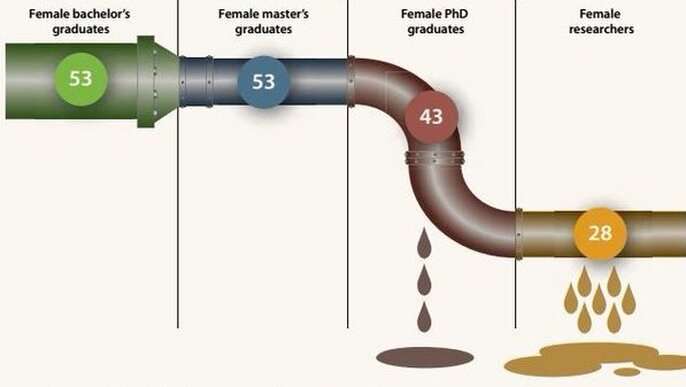|
The metaphor of the leaky pipeline describes how the number of women, Black, Indigenous, People of Color (BIPOC) and other minoritized groups in STEMM (Science, Technology, Engineering, Mathematics, and Medicine) fields progressively decreases at every stage of their academic careers (see Figure below). This phenomenon leads to a loss of talented and skilled people in STEMM, and to a severe under-representation of these groups at the independent investigator and leadership levels.  The leaky pipeline share of women in higher education and research, 2013 (%). Source: UNESCO Institute for Statistics estimates based on data from its database, July 2015. However, the passivity of this approach has often been criticized. Women and BIPOC don’t leak out of the pipeline. Instead, they are forced out of it under pressure behind blockages. In The Leaky Pipeline Playbook, Miranda (2021) explains many actions and behaviors that reinforce and perpetuate the exclusion of women and people of color in STEMM fields. Some of these behaviors are, for example, weaponizing the unwritten curriculum (i.e., Many critical skills for success in an academic career depend on the adviser's willingness to teach them to the advisee), steering down into less prestigious, visible and impactful career opportunities, or qualifying academic achievements (i.e., Assuming that women and BIPOC achievements are due to their adviser’s effort or just due to luck). Only by identifying those pipeline blockages will they be removed. We strongly recommend reading this article (available here). In this regard, another interesting and highly recommendable article has been recently published: Scientists from historically excluded groups face a hostile obstacle course (Berhe et al., 2022). In this work, authors propose to move forward from the passive metaphor of leaky pipeline to the hostile obstacle course. This new metaphor is characterized by the existence of cultural and structural barriers that have been put in place deliberately or unconsciously, to slow down or exclude certain groups. According to the authors, the different experiences of white women, BIPOC, transgender people, religious minorities, academics with disabilities, foreign-born, or international scholars are better represented as a hostile obstacle course. Authors argued that the leaky pipeline fails to represent the experience of many people, because scientific careers are often more like a braided river with multiple routes. In addition, many of the solutions proposed, such as mentoring and recommending historically excluded groups for awards, are patches to the holes in the leaky pipeline, but they are not a real solution. These patches distract from the structural barriers in the scientific institutions, and they do not face the real and documented problems, such as bias in the way that applications are evaluated, bias in the peer-review process, racism, micro- and macroaggresions, sexual harassment, discrimination and other exclusionary behaviours. Moving from the leaky pipeline to the hostile obstacle course means that the “obstacles are not the inevitable consequence of poorly maintained infrastructure; instead, they are barriers that have often been deliberately — or at the very least unconsciously — put in place and sustained”. Because of these obstacles in their careers, scholars from historically excluded groups spend more time and energy to progress, and, in the end, they have to be better than their colleagues to be seen as doing equally. The consequences can vary from the slow down of their careers, to real traumatic experiences that pushed them out of academia. Gender and racial discrimination play a critical role in the decision of women overall, and women of colour in particular, to leave science and academia. Ultimately, this paradigm shift means that the emphasis and responsibility lies in those in power to actively remove the barriers presented in the hostile obstacle course. Only by the identification and acknowledging of these cultural and structural barriers, will they be confronted, and dismantled. And only by dismantling them, we will transform academia in a more diverse and equitable environment. The author of the post: Dr. Elizabeth León-Palmero is a postdoctoral researcher at the University of Southern Denmark (SDU). References:
Miranda, E. A. (2021). The Leaky Pipeline Playbook, Inside Higher Ed. Available at: https://www.insidehighered.com/advice/2021/08/13/actions-and-behaviors-thwart-advancement-women-and-people-color-academe-opinion (Accessed: 2 February 2022). Berhe, A. A., Barnes, R. T., Hastings, M. G., Mattheis, A., Schneider, B., Williams, B. M. and Marín-Spiotta, E. (2022). Scientists from historically excluded groups face a hostile obstacle course, Nature Geoscience, 15(1), pp. 2–4. doi: 10.1038/s41561-021-00868-0.
3 Comments
10/5/2023 09:15:57 pm
<a href="https://www.supplementguidesg.net">Informative Source For Healthcare</a> - [URL=https://www.supplementguidesg.net/]supplementguidesg[/URL]
Reply
10/5/2023 09:16:45 pm
<a href="https://www.guideonproduct.com">guideonproduct</a>
Reply
running shoes
7/6/2023 05:46:28 am
Our shoes are built to last, with durable materials and high-quality construction that can withstand even the most extreme running conditions.
Reply
Leave a Reply. |
CategoriesArchives
March 2024
AuthorDifferent members of the Gender and Science AIL group will contribute to the Blog, as well as invited collaborators. |

 RSS Feed
RSS Feed